Daikin ERGA04EAV3, ERGA06EAV3, ERGA08EAV3, EHVH04SU18EA6V, EHVH04SU23EA6V Installer reference guide
...
Installer reference guide
Daikin Altherma 3 R F
ERGA04EAV3(A)
ERGA06EAV3(A)
ERGA08EAV3(A)
EHVH04SU18EA6V
EHVH04SU23EA6V
EHVH08SU18EA6V
EHVH08SU23EA6V

Table of contents
Table of contents
1 About the documentation |
6 |
|
1.1 |
About this document ...................................................................................................................................................... |
6 |
1.2 |
Meaning of warnings and symbols................................................................................................................................. |
7 |
1.3 |
Installer reference guide at a glance .............................................................................................................................. |
8 |
2 General safety precautions |
9 |
||
2.1 |
For the installer............................................................................................................................................................... |
9 |
|
|
2.1.1 |
General ........................................................................................................................................................... |
9 |
|
2.1.2 |
Installation site ............................................................................................................................................... |
10 |
|
2.1.3 |
Refrigerant — in case of R410A or R32.......................................................................................................... |
10 |
|
2.1.4 |
Water .............................................................................................................................................................. |
12 |
|
2.1.5 |
Electrical ......................................................................................................................................................... |
12 |
3 Specific installer safety instructions |
15 |
|||
|
3.1 |
Instructions for equipment using R32 refrigerant ......................................................................................................... |
18 |
|
4 |
About the box |
20 |
||
|
4.1 |
Overview: About the box ................................................................................................................................................ |
20 |
|
|
4.2 |
Outdoor unit ................................................................................................................................................................... |
20 |
|
|
|
4.2.1 |
To unpack the outdoor unit ........................................................................................................................... |
20 |
|
|
4.2.2 |
To handle the outdoor unit............................................................................................................................ |
21 |
|
|
4.2.3 |
To remove the accessories from the outdoor unit........................................................................................ |
21 |
|
4.3 |
Indoor unit ...................................................................................................................................................................... |
22 |
|
|
|
4.3.1 |
To unpack the indoor unit.............................................................................................................................. |
22 |
|
|
4.3.2 |
To remove the accessories from the indoor unit .......................................................................................... |
22 |
|
|
4.3.3 |
To handle the indoor unit............................................................................................................................... |
23 |
|
4.4 |
Domestic hot water tank kit ........................................................................................................................................... |
23 |
|
|
|
4.4.1 |
To remove the accessories from the domestic hot water tank kit ............................................................... |
23 |
|
4.5 |
Checklist for the required DHW accessories.................................................................................................................. |
23 |
|
5 About the units and options |
25 |
|||
|
5.1 |
Overview: About the units and options.......................................................................................................................... |
25 |
|
|
5.2 |
Identification ................................................................................................................................................................... |
25 |
|
|
|
5.2.1 |
Identification label: Outdoor unit .................................................................................................................. |
25 |
|
|
5.2.2 |
Identification label: Indoor unit ..................................................................................................................... |
26 |
|
5.3 |
Combining units and options.......................................................................................................................................... |
26 |
|
|
|
5.3.1 |
Possible options for the outdoor unit............................................................................................................ |
26 |
|
|
5.3.2 |
Possible options for the indoor unit............................................................................................................... |
27 |
6 |
Application guidelines |
30 |
||
|
6.1 |
Overview: Application guidelines ................................................................................................................................... |
30 |
|
|
6.2 |
Setting up the space heating/cooling system ................................................................................................................ |
30 |
|
|
|
6.2.1 |
Single room..................................................................................................................................................... |
31 |
|
|
6.2.2 |
Multiple rooms – One LWT zone ................................................................................................................... |
35 |
|
|
6.2.3 |
Multiple rooms – Two LWT zones.................................................................................................................. |
39 |
|
6.3 |
Setting up an auxiliary heat source for space heating ................................................................................................... |
41 |
|
|
6.4 |
Setting up the domestic hot water tank......................................................................................................................... |
44 |
|
|
|
6.4.1 |
System layout – Integrated DHW tank........................................................................................................... |
44 |
|
|
6.4.2 |
Selecting the volume and desired temperature for the DHW tank .............................................................. |
44 |
|
|
6.4.3 |
Setup and configuration – DHW tank ............................................................................................................ |
46 |
|
|
6.4.4 |
DHW pump for instant hot water .................................................................................................................. |
46 |
|
|
6.4.5 |
DHW pump for disinfection ........................................................................................................................... |
47 |
|
6.5 |
Setting up the energy metering...................................................................................................................................... |
47 |
|
|
|
6.5.1 |
Produced heat ................................................................................................................................................ |
47 |
|
|
6.5.2 |
Consumed energy........................................................................................................................................... |
48 |
|
|
6.5.3 |
Normal kWh rate power supply ..................................................................................................................... |
48 |
|
|
6.5.4 |
Preferential kWh rate power supply.............................................................................................................. |
50 |
|
6.6 |
Setting up the power consumption control ................................................................................................................... |
51 |
|
|
|
6.6.1 |
Permanent power limitation .......................................................................................................................... |
51 |
|
|
6.6.2 |
Power limitation activated by digital inputs .................................................................................................. |
51 |
|
|
6.6.3 |
Power limitation process................................................................................................................................ |
53 |
|
6.7 |
Setting up an external temperature sensor ................................................................................................................... |
53 |
|
7 |
Unit installation |
55 |
||
|
7.1 |
Preparing the installation site......................................................................................................................................... |
55 |
|
|
|
7.1.1 |
Installation site requirements of the outdoor unit........................................................................................ |
55 |
|
|
|
|
|
Installer reference guide |
|
|
ERGA04~08EAV3(A) + EHVH04+08SU18+23EA6V |
|
2 |
|
|
|
Daikin Altherma 3 R F |
|
|
|
4P629090-1 – 2020.08 |
|

Table of contents
|
|
7.1.2 |
Additional installation site requirements of the outdoor unit in cold climates |
............................................ 58 |
|
|
7.1.3 |
Installation site requirements of the indoor unit .......................................................................................... |
59 |
|
7.2 |
Opening and closing the units ........................................................................................................................................ |
62 |
|
|
|
7.2.1 |
About opening the units................................................................................................................................. |
62 |
|
|
7.2.2 |
To open the outdoor unit............................................................................................................................... |
62 |
|
|
7.2.3 |
To close the outdoor unit............................................................................................................................... |
62 |
|
|
7.2.4 |
To open the indoor unit ................................................................................................................................. |
62 |
|
|
7.2.5 |
To lower the switch box on the indoor unit .................................................................................................. |
64 |
|
|
7.2.6 |
To close the indoor unit ................................................................................................................................. |
65 |
|
7.3 |
Mounting the outdoor unit............................................................................................................................................. |
65 |
|
|
|
7.3.1 |
About mounting the outdoor unit ................................................................................................................. |
65 |
|
|
7.3.2 |
Precautions when mounting the outdoor unit.............................................................................................. |
66 |
|
|
7.3.3 |
To provide the installation structure ............................................................................................................. |
66 |
|
|
7.3.4 |
To install the outdoor unit ............................................................................................................................. |
69 |
|
|
7.3.5 |
To provide drainage........................................................................................................................................ |
70 |
|
|
7.3.6 |
To prevent the outdoor unit from falling over .............................................................................................. |
71 |
|
7.4 |
Mounting the indoor unit ............................................................................................................................................... |
72 |
|
|
|
7.4.1 |
About mounting the indoor unit.................................................................................................................... |
72 |
|
|
7.4.2 |
Precautions when mounting the indoor unit................................................................................................. |
72 |
|
|
7.4.3 |
To install the indoor unit ................................................................................................................................ |
72 |
|
|
7.4.4 |
To connect the drain hose to the drain ......................................................................................................... |
73 |
8 |
Piping installation |
75 |
||
|
8.1 |
Preparing refrigerant piping ........................................................................................................................................... |
75 |
|
|
|
8.1.1 |
Refrigerant piping requirements.................................................................................................................... |
75 |
|
|
8.1.2 |
Refrigerant piping insulation.......................................................................................................................... |
76 |
|
8.2 |
Preparing water piping ................................................................................................................................................... |
76 |
|
|
|
8.2.1 |
Water circuit requirements............................................................................................................................ |
76 |
|
|
8.2.2 |
Formula to calculate the expansion vessel pre-pressure .............................................................................. |
80 |
|
|
8.2.3 |
To check the water volume and flow rate ..................................................................................................... |
80 |
|
|
8.2.4 |
Changing the pre-pressure of the expansion vessel...................................................................................... |
82 |
|
|
8.2.5 |
To check the water volume: Examples .......................................................................................................... |
83 |
|
8.3 |
Connecting the refrigerant piping .................................................................................................................................. |
84 |
|
|
|
8.3.1 |
About connecting the refrigerant piping ....................................................................................................... |
84 |
|
|
8.3.2 |
Precautions when connecting the refrigerant piping.................................................................................... |
84 |
|
|
8.3.3 |
Guidelines when connecting the refrigerant piping...................................................................................... |
85 |
|
|
8.3.4 |
Pipe bending guidelines ................................................................................................................................. |
86 |
|
|
8.3.5 |
To flare the pipe end ...................................................................................................................................... |
86 |
|
|
8.3.6 |
To braze the pipe end..................................................................................................................................... |
87 |
|
|
8.3.7 |
Using the stop valve and service port............................................................................................................ |
87 |
|
|
8.3.8 |
To connect the refrigerant piping to the outdoor unit ................................................................................. |
89 |
|
|
8.3.9 |
To connect the refrigerant piping to the indoor unit .................................................................................... |
89 |
|
8.4 |
Checking the refrigerant piping...................................................................................................................................... |
90 |
|
|
|
8.4.1 |
About checking the refrigerant piping ........................................................................................................... |
90 |
|
|
8.4.2 |
Precautions when checking the refrigerant piping........................................................................................ |
90 |
|
|
8.4.3 |
To check for leaks ........................................................................................................................................... |
91 |
|
|
8.4.4 |
To perform vacuum drying............................................................................................................................. |
91 |
|
|
8.4.5 |
To insulate the refrigerant piping .................................................................................................................. |
92 |
|
8.5 |
Charging refrigerant........................................................................................................................................................ |
93 |
|
|
|
8.5.1 |
About charging refrigerant............................................................................................................................. |
93 |
|
|
8.5.2 |
Precautions when charging refrigerant ......................................................................................................... |
94 |
|
|
8.5.3 |
To determine the additional refrigerant amount.......................................................................................... |
94 |
|
|
8.5.4 |
To determine the complete recharge amount .............................................................................................. |
94 |
|
|
8.5.5 |
To charge additional refrigerant .................................................................................................................... |
94 |
|
|
8.5.6 |
To fix the fluorinated greenhouse gases label............................................................................................... |
95 |
|
8.6 |
Connecting water piping................................................................................................................................................. |
95 |
|
|
|
8.6.1 |
About connecting the water piping ............................................................................................................... |
95 |
|
|
8.6.2 |
Precautions when connecting the water piping............................................................................................ |
96 |
|
|
8.6.3 |
To connect the water piping .......................................................................................................................... |
96 |
|
|
8.6.4 |
To connect the water piping for domestic hot water.................................................................................... |
98 |
|
|
8.6.5 |
To connect the recirculation piping ............................................................................................................... |
101 |
|
|
8.6.6 |
To fill the water circuit ................................................................................................................................... |
101 |
|
|
8.6.7 |
To fill the domestic hot water tank................................................................................................................ |
101 |
|
|
8.6.8 |
To insulate the water piping .......................................................................................................................... |
102 |
9 |
Electrical installation |
103 |
||
|
9.1 |
About connecting the electrical wiring .......................................................................................................................... |
103 |
|
|
|
9.1.1 |
Precautions when connecting the electrical wiring....................................................................................... |
104 |
|
|
9.1.2 |
Guidelines when connecting the electrical wiring......................................................................................... |
105 |
|
|
9.1.3 |
Specifications of standard wiring components.............................................................................................. |
106 |
|
|
|
|
|
ERGA04~08EAV3(A) + EHVH04+08SU18+23EA6V |
|
|
|
Installer reference guide |
Daikin Altherma 3 R F |
|
|
|
3 |
4P629090-1 – 2020.08 |
|
|
|
|

Table of contents
|
9.1.4 |
About electrical compliance........................................................................................................................... |
106 |
|
9.1.5 |
About preferential kWh rate power supply................................................................................................... |
107 |
|
9.1.6 |
Overview of electrical connections except external actuators ..................................................................... |
107 |
9.2 |
Connections to the outdoor unit.................................................................................................................................... |
108 |
|
|
9.2.1 |
To connect the electrical wiring to the outdoor unit .................................................................................... |
108 |
9.3 |
Connections to the indoor unit ...................................................................................................................................... |
110 |
|
|
9.3.1 |
To connect the main power supply................................................................................................................ |
114 |
|
9.3.2 |
To connect the backup heater power supply ................................................................................................ |
116 |
|
9.3.3 |
To connect the shut-off valve ........................................................................................................................ |
118 |
|
9.3.4 |
To connect the electricity meters .................................................................................................................. |
119 |
|
9.3.5 |
To connect the domestic hot water pump .................................................................................................... |
119 |
|
9.3.6 |
To connect the alarm output ......................................................................................................................... |
120 |
|
9.3.7 |
To connect the space cooling/heating ON/OFF output................................................................................. |
121 |
|
9.3.8 |
To connect the changeover to external heat source..................................................................................... |
122 |
|
9.3.9 |
To connect the power consumption digital inputs........................................................................................ |
123 |
|
9.3.10 |
To connect the safety thermostat (normally closed contact) ....................................................................... |
124 |
|
9.3.11 |
To connect a Smart Grid................................................................................................................................. |
125 |
|
9.3.12 |
To connect the WLAN cartridge (delivered as accessory)............................................................................. |
129 |
9.4 |
After connecting the electrical wiring to the indoor unit .............................................................................................. |
129 |
|
10 Configuration |
131 |
||
10.1 |
Overview: Configuration................................................................................................................................................. |
131 |
|
|
10.1.1 |
To access the most used commands ............................................................................................................. |
132 |
10.2 |
Configuration wizard....................................................................................................................................................... |
134 |
|
10.3 |
Possible screens .............................................................................................................................................................. |
135 |
|
|
10.3.1 |
Possible screens: Overview ............................................................................................................................ |
135 |
|
10.3.2 |
Home screen................................................................................................................................................... |
136 |
|
10.3.3 |
Main menu screen.......................................................................................................................................... |
139 |
|
10.3.4 |
Menu screen................................................................................................................................................... |
140 |
|
10.3.5 |
Setpoint screen............................................................................................................................................... |
140 |
|
10.3.6 |
Detailed screen with values ........................................................................................................................... |
141 |
|
10.3.7 |
Schedule screen: Example.............................................................................................................................. |
141 |
10.4 |
Weather-dependent curve ............................................................................................................................................. |
146 |
|
|
10.4.1 |
What is a weather-dependent curve? ........................................................................................................... |
146 |
|
10.4.2 |
2-points curve................................................................................................................................................. |
146 |
|
10.4.3 |
Slope-offset curve........................................................................................................................................... |
147 |
|
10.4.4 |
Using weather-dependent curves.................................................................................................................. |
149 |
10.5 |
Settings menu ................................................................................................................................................................. |
151 |
|
|
10.5.1 |
Malfunctioning ............................................................................................................................................... |
151 |
|
10.5.2 |
Room............................................................................................................................................................... |
151 |
|
10.5.3 |
Main zone ....................................................................................................................................................... |
155 |
|
10.5.4 |
Additional zone............................................................................................................................................... |
165 |
|
10.5.5 |
Space heating/cooling .................................................................................................................................... |
171 |
|
10.5.6 |
Tank................................................................................................................................................................. |
179 |
|
10.5.7 |
User settings ................................................................................................................................................... |
186 |
|
10.5.8 |
Information..................................................................................................................................................... |
191 |
|
10.5.9 |
Installer settings ............................................................................................................................................. |
192 |
|
10.5.10 |
Operation........................................................................................................................................................ |
209 |
|
10.5.11 |
WLAN .............................................................................................................................................................. |
210 |
10.6 |
Menu structure: Overview user settings........................................................................................................................ |
212 |
|
10.7 |
Menu structure: Overview installer settings.................................................................................................................. |
214 |
|
11 Commissioning |
215 |
||
11.1 |
Overview: Commissioning .............................................................................................................................................. |
215 |
|
11.2 |
Precautions when commissioning.................................................................................................................................. |
216 |
|
11.3 |
Checklist before commissioning..................................................................................................................................... |
216 |
|
11.4 |
Checklist during commissioning ..................................................................................................................................... |
217 |
|
|
11.4.1 |
Minimum flow rate......................................................................................................................................... |
217 |
|
11.4.2 |
Air purge function........................................................................................................................................... |
217 |
|
11.4.3 |
Operation test run.......................................................................................................................................... |
219 |
|
11.4.4 |
Actuator test run ............................................................................................................................................ |
220 |
|
11.4.5 Underfloor heating screed dryout ................................................................................................................. |
221 |
|
12 Hand-over to the user |
225 |
||
13 Maintenance and service |
226 |
||
13.1 |
Overview: Maintenance and service .............................................................................................................................. |
226 |
|
13.2 |
Maintenance safety precautions.................................................................................................................................... |
226 |
|
13.3 |
Yearly maintenance ........................................................................................................................................................ |
227 |
|
|
13.3.1 Yearly maintenance outdoor unit: overview ................................................................................................. |
227 |
|
|
13.3.2 Yearly maintenance outdoor unit: instructions............................................................................................. |
227 |
|
|
|
|
|
Installer reference guide |
|
|
ERGA04~08EAV3(A) + EHVH04+08SU18+23EA6V |
4 |
|
|
Daikin Altherma 3 R F |
|
|
4P629090-1 – 2020.08 |
|

|
|
Table of contents |
|
|
13.3.3 |
Yearly maintenance indoor unit: overview.................................................................................................... |
227 |
|
13.3.4 |
Yearly maintenance indoor unit: instructions ............................................................................................... |
227 |
13.4 |
To drain the domestic hot water tank............................................................................................................................ |
230 |
|
13.5 |
To inspect the inside of the domestic hot water tank ................................................................................................... |
231 |
|
13.6 |
About cleaning the water filter in case of trouble ......................................................................................................... |
232 |
|
|
13.6.1 |
To remove the water filter ............................................................................................................................. |
232 |
|
13.6.2 |
To clean the water filter in case of trouble.................................................................................................... |
233 |
|
13.6.3 |
To install the water filter ................................................................................................................................ |
234 |
14 Troubleshooting |
235 |
||
14.1 |
Overview: Troubleshooting ............................................................................................................................................ |
235 |
|
14.2 |
Precautions when troubleshooting ................................................................................................................................ |
235 |
|
14.3 |
Solving problems based on symptoms........................................................................................................................... |
236 |
|
|
14.3.1 |
Symptom: The unit is NOT heating or cooling as expected........................................................................... |
236 |
|
14.3.2 |
Symptom: Hot water does NOT reach the desired temperature.................................................................. |
237 |
|
14.3.3 |
Symptom: The compressor does NOT start (space heating or domestic water heating) ............................ |
237 |
|
14.3.4 |
Symptom: The system is making gurgling noises after commissioning ........................................................ |
237 |
|
14.3.5 |
Symptom: The pump is making noise (cavitation)......................................................................................... |
238 |
|
14.3.6 |
Symptom: The pressure relief valve opens.................................................................................................... |
238 |
|
14.3.7 |
Symptom: The water pressure relief valve leaks........................................................................................... |
239 |
|
14.3.8 |
Symptom: The space is NOT sufficiently heated at low outdoor temperatures........................................... |
239 |
|
14.3.9 |
Symptom: The pressure at the tapping point is temporarily unusually high................................................ |
240 |
|
14.3.10 |
Symptom: Decoration panels are pushed away due to a swollen tank ........................................................ |
240 |
|
14.3.11 |
Symptom: Tank disinfection function is NOT completed correctly (AH-error)............................................. |
240 |
14.4 |
Solving problems based on error codes ......................................................................................................................... |
241 |
|
|
14.4.1 |
To display the help text in case of a malfunction .......................................................................................... |
241 |
|
14.4.2 |
Error codes: Overview .................................................................................................................................... |
242 |
15 Disposal |
|
246 |
|
15.1 |
Overview: Disposal.......................................................................................................................................................... |
246 |
|
15.2 |
To pump down ................................................................................................................................................................ |
246 |
|
15.3 |
To start and stop forced cooling..................................................................................................................................... |
247 |
|
16 Technical data |
249 |
||
16.1 |
Piping diagram: Outdoor unit ......................................................................................................................................... |
249 |
|
16.2 |
Piping diagram: Indoor unit ............................................................................................................................................ |
251 |
|
16.3 |
Wiring diagram: Outdoor unit ........................................................................................................................................ |
252 |
|
16.4 |
Wiring diagram: Indoor unit ........................................................................................................................................... |
254 |
|
16.5 |
Table 1 – Maximum refrigerant charge allowed in a room: indoor unit ....................................................................... |
260 |
|
16.6 |
Table 2 – Minimum floor area: indoor unit.................................................................................................................... |
261 |
|
16.7 |
Table 3 – Minimum venting opening area for natural ventilation: indoor unit ............................................................ |
261 |
|
16.8 |
ESP curve: Indoor unit..................................................................................................................................................... |
263 |
|
16.9 |
Technical specifications: Domestic hot water tank........................................................................................................ |
263 |
|
|
16.9.1 |
Test results in accordance with EN12897 (2016) .......................................................................................... |
263 |
|
16.9.2 |
Warning label.................................................................................................................................................. |
264 |
17 Glossary |
|
265 |
|
18 Field settings table |
266 |
||
ERGA04~08EAV3(A) + EHVH04+08SU18+23EA6V |
Installer reference guide |
Daikin Altherma 3 R F |
5 |
4P629090-1 – 2020.08 |

1 | About the documentation
1 About the documentation
In this chapter
1.1 |
About this document.............................................................................................................................................................. |
6 |
1.2 |
Meaning of warnings and symbols......................................................................................................................................... |
7 |
1.3 |
Installer reference guide at a glance...................................................................................................................................... |
8 |
1.1 About this document
INFORMATION
Make sure that the user has the printed documentation and ask him/her to keep it
for future reference.
Target audience
Authorised installers
Documentation set
This document is part of a documentation set. The complete set consists of:
▪General safety precautions:
-Safety instructions that you must read before installing
-Format: Paper (in the box of the indoor unit)
▪Indoor unit installation manual:
-Installation instructions
-Format: Paper (in the box of the indoor unit)
▪Outdoor unit installation manual:
-Installation instructions
-Format: Paper (in the box of the outdoor unit)
▪Installer reference guide:
-Preparation of the installation, good practices, reference data,…
-Format: Digital files on http://www.daikineurope.com/support-and-manuals/ product-information/
▪Addendum book for optional equipment:
-Additional info about how to install optional equipment
-Format: Paper (in the box of the indoor unit) + Digital files on http:// www.daikineurope.com/support-and-manuals/product-information/
Latest revisions of the supplied documentation may be available on the regional
Daikin website or via your dealer.
The original documentation is written in English. All other languages are translations.
Technical engineering data
▪A subset of the latest technical data is available on the regional Daikin website (publicly accessible).
▪The full set of latest technical data is available on the Daikin Business Portal (authentication required).
Installer reference guide |
ERGA04~08EAV3(A) + EHVH04+08SU18+23EA6V |
6 |
Daikin Altherma 3 R F |
4P629090-1 – 2020.08 |
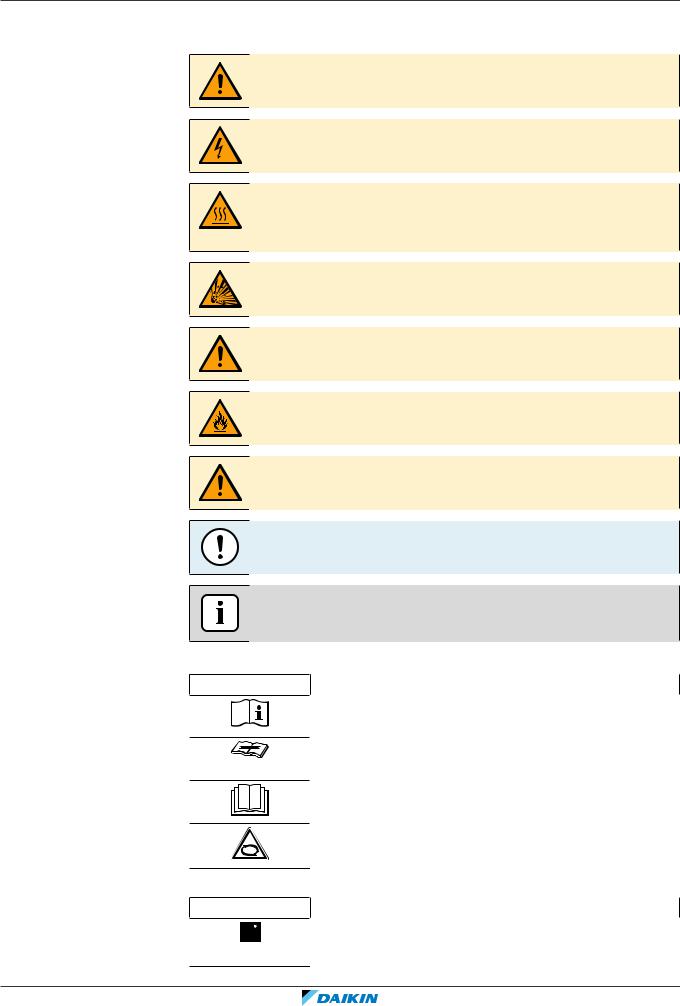
1 | About the documentation
1.2 Meaning of warnings and symbols
DANGER
Indicates a situation that results in death or serious injury.
DANGER: RISK OF ELECTROCUTION
Indicates a situation that could result in electrocution.
DANGER: RISK OF BURNING/SCALDING
Indicates a situation that could result in burning/scalding because of extreme hot or cold temperatures.
DANGER: RISK OF EXPLOSION
Indicates a situation that could result in explosion.
WARNING
Indicates a situation that could result in death or serious injury.
WARNING: FLAMMABLE MATERIAL
CAUTION
Indicates a situation that could result in minor or moderate injury.
NOTICE
Indicates a situation that could result in equipment or property damage.
INFORMATION
Indicates useful tips or additional information.
Symbols used on the unit:
Symbol |
Explanation |
Before installation, read the installation and operation manual, and the wiring instruction sheet.
Before performing maintenance and service tasks, read the service manual.
For more information, see the installer and user reference guide.
The unit contains rotating parts. Be careful when servicing or inspecting the unit.
Symbols used in the documentation:
Symbol |
Explanation |
Indicates a figure title or a reference to it.
Example: " 1–3 Figure title" means "Figure 3 in chapter 1".
1–3 Figure title" means "Figure 3 in chapter 1".
ERGA04~08EAV3(A) + EHVH04+08SU18+23EA6V |
Installer reference guide |
Daikin Altherma 3 R F |
7 |
4P629090-1 – 2020.08 |
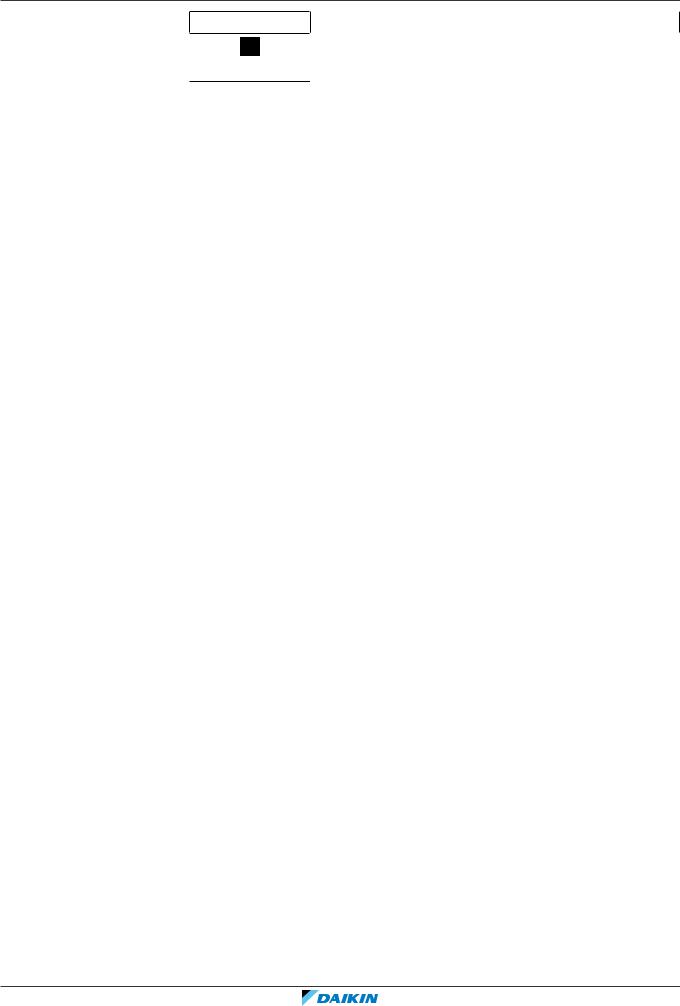
1 | About the documentation
Symbol |
Explanation |
Indicates a table title or a reference to it.
Example: " 1–3 Table title" means "Table 3 in chapter 1".
1–3 Table title" means "Table 3 in chapter 1".
1.3 Installer reference guide at a glance
Chapter |
|
Description |
General safety precautions |
Safety instructions that you must read before |
|
|
installing |
|
|
|
|
About the documentation |
What documentation exists for the installer |
|
|
|
|
About the box |
How to unpack the units and remove their |
|
|
accessories |
|
|
|
|
About the units and options |
▪ |
How to identify the units |
|
▪ |
Possible combinations of units and options |
|
|
|
Application guidelines |
Various installation setups of the system |
|
|
|
|
Preparation |
What to do and know before going on site |
|
|
|
|
Installation |
What to do and know to install the system |
|
|
|
|
Configuration |
What to do and know to configure the system |
|
|
after it is installed |
|
|
|
|
Commissioning |
What to do and know to commission the system |
|
|
after it is configured |
|
|
|
|
Hand over to the user |
What to give and explain to the user |
|
|
|
|
Maintenance and service |
How to maintain and service the units |
|
|
|
|
Troubleshooting |
What to do in case of problems |
|
|
|
|
Disposal |
How to dispose of the system |
|
|
|
|
Technical data |
Specifications of the system |
|
|
|
|
Glossary |
Definition of terms |
|
|
|
|
Field settings table |
Table to be filled in by the installer, and kept for |
|
|
future reference |
|
|
Note: There is also an installer settings table in |
|
|
the user reference guide. This table has to be |
|
|
filled in by the installer and handed over to the |
|
|
user. |
|
|
|
|
Installer reference guide |
ERGA04~08EAV3(A) + EHVH04+08SU18+23EA6V |
8 |
Daikin Altherma 3 R F |
4P629090-1 – 2020.08 |

2 | General safety precautions
2 General safety precautions
In this chapter
2.1 |
For the installer....................................................................................................................................................................... |
9 |
|
|
2.1.1 |
General ................................................................................................................................................................... |
9 |
|
2.1.2 |
Installation site ....................................................................................................................................................... |
10 |
|
2.1.3 |
Refrigerant — in case of R410A or R32 ................................................................................................................. |
10 |
|
2.1.4 |
Water...................................................................................................................................................................... |
12 |
|
2.1.5 |
Electrical ................................................................................................................................................................. |
12 |
2.1 For the installer
2.1.1 General
If you are NOT sure how to install or operate the unit, contact your dealer.
DANGER: RISK OF BURNING/SCALDING
▪Do NOT touch the refrigerant piping, water piping or internal parts during and immediately after operation. It could be too hot or too cold. Give it time to return to normal temperature. If you must touch it, wear protective gloves.
▪Do NOT touch any accidental leaking refrigerant.
WARNING
Improper installation or attachment of equipment or accessories could result in electrical shock, short-circuit, leaks, fire or other damage to the equipment. Only use accessories, optional equipment and spare parts made or approved by Daikin.
WARNING
Make sure installation, testing and applied materials comply with applicable legislation (on top of the instructions described in the Daikin documentation).
CAUTION
Wear adequate personal protective equipment (protective gloves, safety glasses,…) when installing, maintaining or servicing the system.
WARNING
Tear apart and throw away plastic packaging bags so that nobody, especially children, can play with them. Possible risk: suffocation.
WARNING
Provide adequate measures to prevent that the unit can be used as a shelter by small animals. Small animals that make contact with electrical parts can cause malfunctions, smoke or fire.
CAUTION
Do NOT touch the air inlet or aluminium fins of the unit.
ERGA04~08EAV3(A) + EHVH04+08SU18+23EA6V |
Installer reference guide |
Daikin Altherma 3 R F |
9 |
4P629090-1 – 2020.08 |

2 | General safety precautions
CAUTION
▪ Do NOT place any objects or equipment on top of the unit.
▪ Do NOT sit, climb or stand on the unit.
NOTICE
Works executed on the outdoor unit are best done under dry weather conditions to avoid water ingress.
In accordance with the applicable legislation, it might be necessary to provide a logbook with the product containing at least: information on maintenance, repair work, results of tests, stand-by periods,…
Also, at least, following information MUST be provided at an accessible place at the product:
▪Instructions for shutting down the system in case of an emergency
▪Name and address of fire department, police and hospital
▪Name, address and day and night telephone numbers for obtaining service In Europe, EN378 provides the necessary guidance for this logbook.
2.1.2Installation site
▪Provide sufficient space around the unit for servicing and air circulation.
▪Make sure the installation site withstands the weight and vibration of the unit.
▪Make sure the area is well ventilated. Do NOT block any ventilation openings.
▪Make sure the unit is level.
Do NOT install the unit in the following places:
▪In potentially explosive atmospheres.
▪In places where there is machinery that emits electromagnetic waves. Electromagnetic waves may disturb the control system, and cause malfunction of the equipment.
▪In places where there is a risk of fire due to the leakage of flammable gases (example: thinner or gasoline), carbon fibre, ignitable dust.
▪In places where corrosive gas (example: sulphurous acid gas) is produced. Corrosion of copper pipes or soldered parts may cause the refrigerant to leak.
2.1.3Refrigerant — in case of R410A or R32
If applicable. See the installation manual or installer reference guide of your
application for more information.
NOTICE
Make sure refrigerant piping installation complies with applicable legislation. In
Europe, EN378 is the applicable standard.
NOTICE
Make sure the field piping and connections are NOT subjected to stress.
Installer reference guide |
ERGA04~08EAV3(A) + EHVH04+08SU18+23EA6V |
10 |
Daikin Altherma 3 R F |
4P629090-1 – 2020.08 |
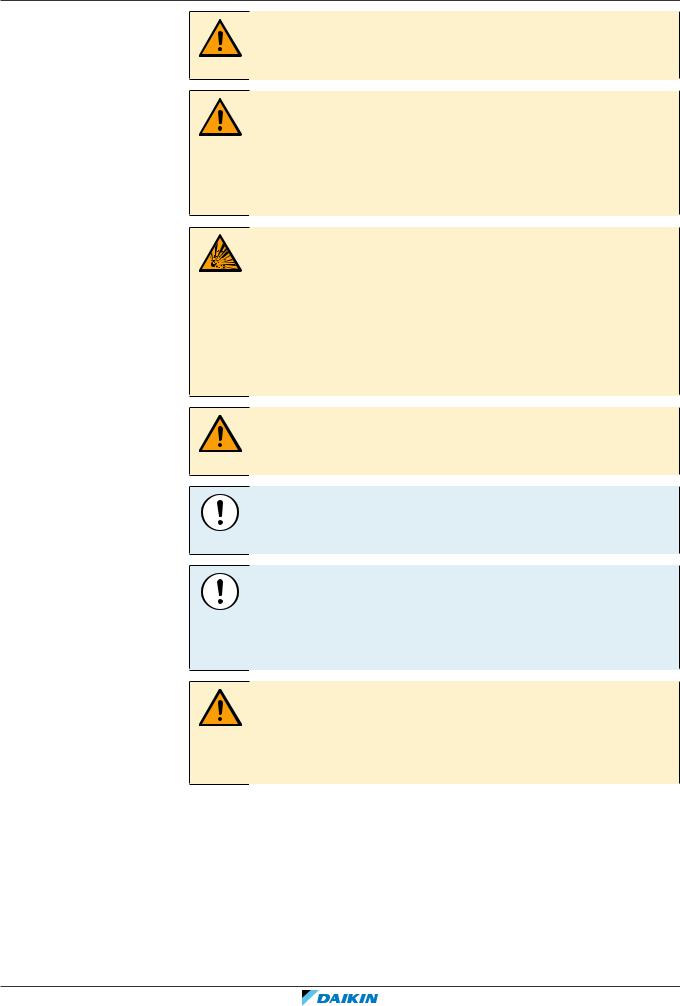
2 | General safety precautions
WARNING
During tests, NEVER pressurize the product with a pressure higher than the maximum allowable pressure (as indicated on the nameplate of the unit).
WARNING
Take sufficient precautions in case of refrigerant leakage. If refrigerant gas leaks, ventilate the area immediately. Possible risks:
▪Excessive refrigerant concentrations in a closed room can lead to oxygen deficiency.
▪Toxic gas might be produced if refrigerant gas comes into contact with fire.
DANGER: RISK OF EXPLOSION
Pump down – Refrigerant leakage. If you want to pump down the system, and there is a leak in the refrigerant circuit:
▪Do NOT use the unit's automatic pump down function, with which you can collect all refrigerant from the system into the outdoor unit. Possible consequence: Selfcombustion and explosion of the compressor because of air going into the operating compressor.
▪Use a separate recovery system so that the unit's compressor does NOT have to operate.
WARNING
ALWAYS recover the refrigerant. Do NOT release them directly into the environment.
Use a vacuum pump to evacuate the installation.
NOTICE
After all the piping has been connected, make sure there is no gas leak. Use nitrogen to perform a gas leak detection.
NOTICE
▪ To avoid compressor breakdown, do NOT charge more than the specified amount of refrigerant.
▪When the refrigerant system is to be opened, refrigerant MUST be treated according to the applicable legislation.
WARNING
Make sure there is no oxygen in the system. Refrigerant may only be charged after performing the leak test and the vacuum drying.
Possible consequence: Self-combustion and explosion of the compressor because of oxygen going into the operating compressor.
▪In case recharge is required, see the nameplate of the unit. It states the type of refrigerant and necessary amount.
▪The unit is factory charged with refrigerant and depending on pipe sizes and pipe lengths some systems require additional charging of refrigerant.
▪Only use tools exclusively for the refrigerant type used in the system, this to ensure pressure resistance and prevent foreign materials from entering into the system.
▪Charge the liquid refrigerant as follows:
ERGA04~08EAV3(A) + EHVH04+08SU18+23EA6V |
Installer reference guide |
Daikin Altherma 3 R F |
11 |
4P629090-1 – 2020.08 |

2 | General safety precautions
If |
Then |
||
A siphon tube is present |
Charge with the cylinder upright. |
||
(i.e., the cylinder is marked with "Liquid |
|
|
|
filling siphon attached") |
|
|
|
|
|
||
A siphon tube is NOT present |
Charge with the cylinder upside down. |
||
|
|
|
|
|
|
|
|
▪Open refrigerant cylinders slowly.
▪Charge the refrigerant in liquid form. Adding it in gas form may prevent normal operation.
CAUTION
When the refrigerant charging procedure is done or when pausing, close the valve of the refrigerant tank immediately. If the valve is NOT closed immediately, remaining pressure might charge additional refrigerant. Possible consequence: Incorrect refrigerant amount.
2.1.4 Water
If applicable. See the installation manual or installer reference guide of your
application for more information.
NOTICE
Make sure water quality complies with EU directive 98/83 EC.
2.1.5 Electrical
DANGER: RISK OF ELECTROCUTION
▪Turn OFF all power supply before removing the switch box cover, connecting electrical wiring or touching electrical parts.
▪Disconnect the power supply for more than 10 minutes, and measure the voltage at the terminals of main circuit capacitors or electrical components before servicing. The voltage MUST be less than 50 V DC before you can touch electrical components. For the location of the terminals, see the wiring diagram.
▪Do NOT touch electrical components with wet hands.
▪Do NOT leave the unit unattended when the service cover is removed.
WARNING
If NOT factory installed, a main switch or other means for disconnection, having a contact separation in all poles providing full disconnection under overvoltage category III condition, MUST be installed in the fixed wiring.
Installer reference guide |
ERGA04~08EAV3(A) + EHVH04+08SU18+23EA6V |
12 |
Daikin Altherma 3 R F |
4P629090-1 – 2020.08 |
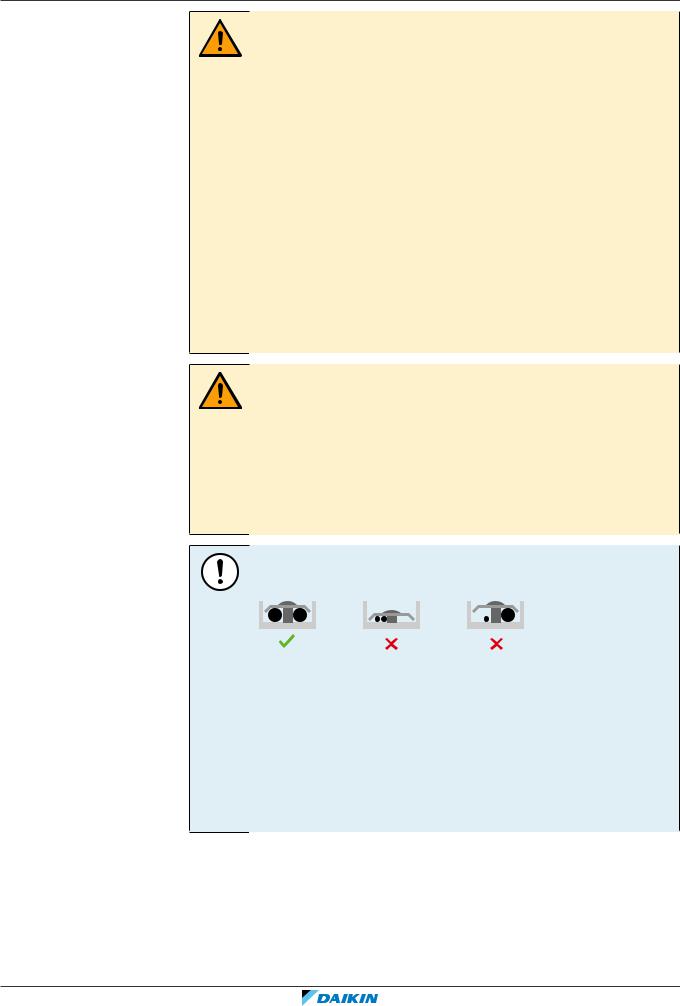
2 | General safety precautions
WARNING
▪ ONLY use copper wires.
▪Make sure the field wiring complies with the applicable legislation.
▪All field wiring MUST be performed in accordance with the wiring diagram supplied with the product.
▪NEVER squeeze bundled cables and make sure they do NOT come in contact with the piping and sharp edges. Make sure no external pressure is applied to the terminal connections.
▪Make sure to install earth wiring. Do NOT earth the unit to a utility pipe, surge absorber, or telephone earth. Incomplete earth may cause electrical shock.
▪Make sure to use a dedicated power circuit. NEVER use a power supply shared by another appliance.
▪Make sure to install the required fuses or circuit breakers.
▪Make sure to install an earth leakage protector. Failure to do so may cause electrical shock or fire.
▪When installing the earth leakage protector, make sure it is compatible with the inverter (resistant to high frequency electric noise) to avoid unnecessary opening of the earth leakage protector.
CAUTION
▪ When connecting the power supply: connect the earth cable first, before making the current-carrying connections.
▪When disconnecting the power supply: disconnect the current-carrying cables first, before separating the earth connection.
▪The length of the conductors between the power supply stress relief and the terminal block itself must be as such that the current-carrying wires are tautened before the earth wire is in case the power supply is pulled loose from the stress relief.
NOTICE
Precautions when laying power wiring:
▪Do NOT connect wiring of different thicknesses to the power terminal block (slack in the power wiring may cause abnormal heat).
▪When connecting wiring which is the same thickness, do as shown in the figure above.
▪For wiring, use the designated power wire and connect firmly, then secure to prevent outside pressure being exerted on the terminal board.
▪Use an appropriate screwdriver for tightening the terminal screws. A screwdriver with a small head will damage the head and make proper tightening impossible.
▪Over-tightening the terminal screws may break them.
Install power cables at least 1 m away from televisions or radios to prevent interference. Depending on the radio waves, a distance of 1 m may not be sufficient.
ERGA04~08EAV3(A) + EHVH04+08SU18+23EA6V |
Installer reference guide |
Daikin Altherma 3 R F |
13 |
4P629090-1 – 2020.08 |

2 | General safety precautions
WARNING
▪ After finishing the electrical work, confirm that each electrical component and terminal inside the electrical components box is connected securely.
▪ Make sure all covers are closed before starting up the unit.
NOTICE
Only applicable if the power supply is three phase, and the compressor has an ON/
OFF starting method.
If there exists the possibility of reversed phase after a momentary black out and the power goes on and off while the product is operating, attach a reversed phase protection circuit locally. Running the product in reversed phase can break the compressor and other parts.
Installer reference guide |
ERGA04~08EAV3(A) + EHVH04+08SU18+23EA6V |
14 |
Daikin Altherma 3 R F |
4P629090-1 – 2020.08 |

3 | Specific installer safety instructions
3 Specific installer safety instructions
Always observe the following safety instructions and regulations.
Application guidelines (see "6 Application guidelines" [430])
CAUTION
If there is more than one leaving water zone, ALWAYS install a mixing valve station in the main zone to decrease (in heating)/increase (in cooling) the leaving water temperature when the additional zone has demand.
Installation site (see "7.1 Preparing the installation site" [455])
WARNING
The appliance shall be stored in a room without continuously operating ignition sources (example: open flames, an operating gas appliance or an operating electric heater).
WARNING
DO NOT reuse refrigerant piping that has been used with any other refrigerant.
Replace the refrigerant pipes or clean thoroughly.
WARNING
▪ Do NOT pierce or burn.
▪Do NOT use means to accelerate the defrosting process or to clean the equipment, other than those recommended by the manufacturer.
▪Be aware that R32 refrigerant does NOT contain an odour.
WARNING
The appliance shall be stored so as to prevent mechanical damage and in a wellventilated room without continuously operating ignition sources (example: open flames, an operating gas appliance or an operating electric heater) and have a room size as specified below.
Charging refrigerant (see "8.5 Charging refrigerant" [493])
WARNING
If the total refrigerant charge in the system is ≥1.84 kg (i.e. if the piping length is
≥27 m), you need to comply with the minimum floor area requirements for the indoor unit. For more information, see "7.1.3 Installation site requirements of the indoor unit" 4[ 59].
CAUTION
To avoid compressor breakdown, do NOT charge more than the specified amount of refrigerant.
WARNING
▪ Only use R32 as refrigerant. Other substances may cause explosions and accidents.
▪R32 contains fluorinated greenhouse gases. Its global warming potential (GWP) value is 675. Do NOT vent these gases into the atmosphere.
▪When charging refrigerant, ALWAYS use protective gloves and safety glasses.
ERGA04~08EAV3(A) + EHVH04+08SU18+23EA6V |
Installer reference guide |
Daikin Altherma 3 R F |
15 |
4P629090-1 – 2020.08 |
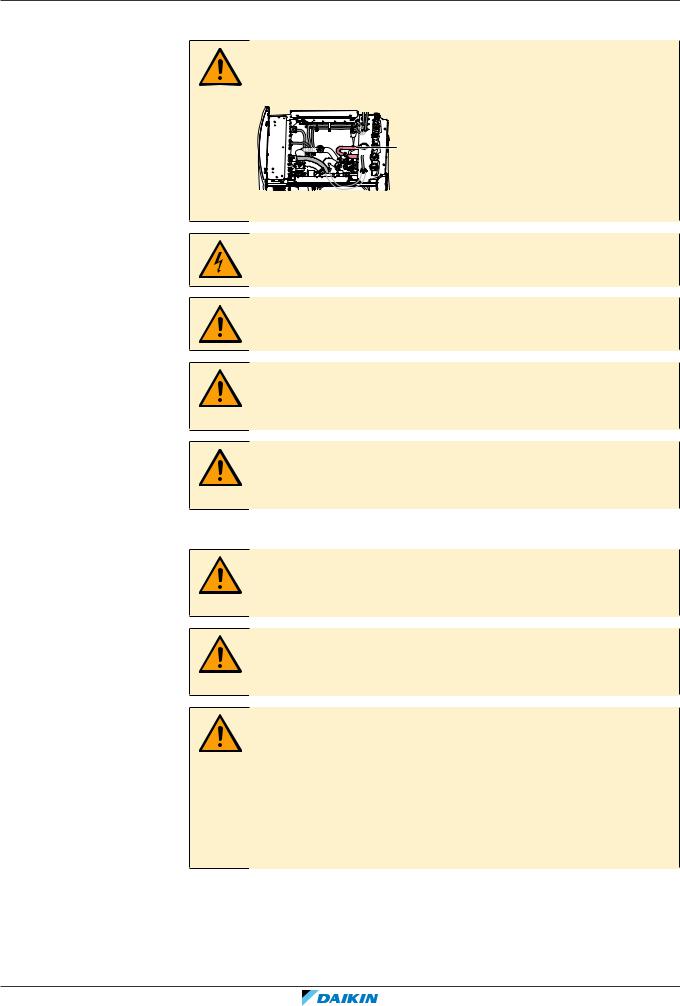
3 | Specific installer safety instructions
Electrical installation (see "9 Electrical installation" [4103])
WARNING
Make sure that the electrical wiring does NOT touch the refrigerant gas pipe, which can be very hot.
a
a Refrigerant gas pipe
DANGER: RISK OF ELECTROCUTION
WARNING
ALWAYS use multicore cable for power supply cables.
CAUTION
To guarantee the unit is completely earthed, always connect the backup heater power supply and the earth cable.
WARNING
The backup heater MUST have a dedicated power supply and MUST be protected by the safety devices required by the applicable legislation.
Configuration (see "10 Configuration" [4131])
CAUTION
The disinfection function settings MUST be configured by the installer according to the applicable legislation.
CAUTION
Be sure that the disinfection function start time [5.7.3] with defined duration [5.7.5] is NOT interrupted by possible domestic hot water demand.
WARNING
Be aware that the domestic hot water temperature at the hot water tap will be equal to the value selected in field setting [2-03] after a disinfection operation.
When the high domestic hot water temperature can be a potential risk for human injuries, a mixing valve (field supply) shall be installed at the hot water outlet connection of the domestic hot water tank. This mixing valve shall secure that the hot water temperature at the hot water tap never rise above a set maximum value. This maximum allowable hot water temperature shall be selected according to the applicable legislation.
Installer reference guide |
ERGA04~08EAV3(A) + EHVH04+08SU18+23EA6V |
16 |
Daikin Altherma 3 R F |
4P629090-1 – 2020.08 |

3 | Specific installer safety instructions
CAUTION
Make sure to observe all rules mentioned in application guideline 5 when bivalent operation function is enabled.
Daikin shall NOT be held liable for any damage resulting from failure to observe this rule.
Maintenance and service (see "13 Maintenance and service" [4226])
CAUTION
Water coming out of the valve may be very hot.
WARNING
If the internal wiring is damaged, it has to be replaced by the manufacturer, its service agent or similarly qualified persons.
CAUTION
Although the water circuit is drained, some water may be spilled when removing the magnetic filter/dirt separator from the filter housing. ALWAYS clean up spilled water.
CAUTION
To protect the piping connected to the magnetic filter/dirt separator from damage it is recommended to perform this procedure with the magnetic filter/dirt separator removed from the unit.
CAUTION
Opening the magnetic filter/dirt separator is ONLY required in case of severe issues. Preferably this action is never to be done during the complete lifetime of the magnetic filter/dirt separator.
CAUTION
Check the condition of the O-rings and replace if needed. Apply water to the O-rings before installation.
CAUTION
Make sure to open the valve (if equipped) towards the expansion vessel, otherwise the overpressure will be generated.
Troubleshooting (see "14 Troubleshooting" [4235])
WARNING
Prevent hazards due to inadvertent resetting of the thermal cut-out: power to this appliance MUST NOT be supplied through an external switching device, such as a timer, or connected to a circuit that is regularly turned ON and OFF by the utility.
ERGA04~08EAV3(A) + EHVH04+08SU18+23EA6V |
Installer reference guide |
Daikin Altherma 3 R F |
17 |
4P629090-1 – 2020.08 |
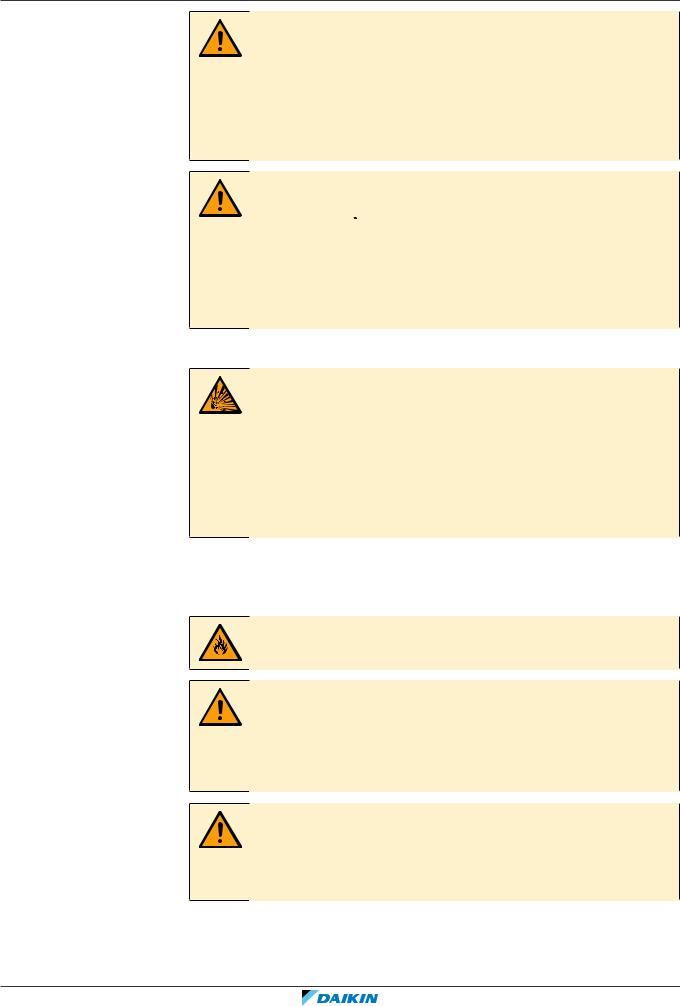
3 | Specific installer safety instructions
WARNING
▪ When carrying out an inspection on the switch box of the unit, ALWAYS make sure that the unit is disconnected from the mains. Turn off the respective circuit breaker.
▪When a safety device was activated, stop the unit and find out why the safety device was activated before resetting it. NEVER shunt safety devices or change their values to a value other than the factory default setting. If you are unable to find the cause of the problem, call your dealer.
WARNING
Air purging heat emitters or collectors. Before you purge air from heat emitters or collectors, check if  or
or  is displayed on the home screen of the user interface.
is displayed on the home screen of the user interface.
▪If not, you can purge air immediately.
▪If yes, make sure that the room where you want to purge air is sufficiently ventilated. Reason: Refrigerant might leak into the water circuit, and subsequently into the room when you purge air from the heat emitters or collectors.
Disposal (see "15 Disposal" [4246])
DANGER: RISK OF EXPLOSION
Pump down – Refrigerant leakage. If you want to pump down the system, and there
is a leak in the refrigerant circuit:
▪Do NOT use the unit's automatic pump down function, with which you can collect all refrigerant from the system into the outdoor unit. Possible consequence: Selfcombustion and explosion of the compressor because of air going into the operating compressor.
▪Use a separate recovery system so that the unit's compressor does NOT have to operate.
3.1Instructions for equipment using R32 refrigerant
WARNING: FLAMMABLE MATERIAL
The refrigerant inside this unit is mildly flammable.
WARNING
▪ Do NOT pierce or burn.
▪Do NOT use means to accelerate the defrosting process or to clean the equipment, other than those recommended by the manufacturer.
▪Be aware that R32 refrigerant does NOT contain an odour.
WARNING
The appliance shall be stored so as to prevent mechanical damage and in a wellventilated room without continuously operating ignition sources (example: open flames, an operating gas appliance or an operating electric heater) and have a room size as specified below.
Installer reference guide |
ERGA04~08EAV3(A) + EHVH04+08SU18+23EA6V |
18 |
Daikin Altherma 3 R F |
4P629090-1 – 2020.08 |

3 | Specific installer safety instructions
WARNING
Make sure installation, servicing, maintenance and repair comply with instructions from Daikin and with applicable legislation (for example national gas regulation) and are executed only by authorised persons.
WARNING
If one or more rooms are connected to the unit using a duct system, make sure:
▪there are no operating ignition sources (example: open flames, an operating gas appliance or an operating electric heater) in case the floor area is less than the minimum floor area A (m²).
▪no auxiliary devices, which may be a potential ignition source, are installed in the duct work (example: hot surfaces with a temperature exceeding 700°C and electric switching device);
▪only auxiliary devices approved by the manufacturer are used in the duct work;
▪air inlet AND outlet are connected directly to the same room by ducting. Do NOT use spaces such as a false ceiling as a duct for the air inlet or outlet.
NOTICE
▪ Precautions shall be taken to avoid excessive vibration or pulsation to refrigeration piping.
▪Protection devices, piping and fittings shall be protected as far as possible against adverse environmental effects.
▪Provision shall be made for expansion and contraction of long runs of piping.
▪Piping in refrigerating systems shall be designed and installed such as to minimise the likelihood of hydraulic shock damaging the system.
▪The indoor equipment and pipes shall be securely mounted and guarded such that accidental rupture of equipment or pipes cannot occur from events such as moving furniture or reconstruction activities.
CAUTION
Do NOT use potential sources of ignition in searching for or detection of refrigerant leaks.
NOTICE
▪ Do NOT re-use joints and copper gaskets which have been used already.
▪Joints made in installation between parts of refrigerant system shall be accessible for maintenance purposes.
ERGA04~08EAV3(A) + EHVH04+08SU18+23EA6V |
Installer reference guide |
Daikin Altherma 3 R F |
19 |
4P629090-1 – 2020.08 |

4 | About the box
4 About the box
In this chapter
4.1 |
Overview: About the box........................................................................................................................................................ |
20 |
|
4.2 |
Outdoor unit ........................................................................................................................................................................... |
20 |
|
|
4.2.1 |
To unpack the outdoor unit ................................................................................................................................... |
20 |
|
4.2.2 |
To handle the outdoor unit.................................................................................................................................... |
21 |
|
4.2.3 |
To remove the accessories from the outdoor unit ............................................................................................... |
21 |
4.3 |
Indoor unit .............................................................................................................................................................................. |
22 |
|
|
4.3.1 |
To unpack the indoor unit...................................................................................................................................... |
22 |
|
4.3.2 |
To remove the accessories from the indoor unit .................................................................................................. |
22 |
|
4.3.3 |
To handle the indoor unit ...................................................................................................................................... |
23 |
4.4 |
Domestic hot water tank kit ................................................................................................................................................... |
23 |
|
|
4.4.1 |
To remove the accessories from the domestic hot water tank kit ....................................................................... |
23 |
4.5 |
Checklist for the required DHW accessories.......................................................................................................................... |
23 |
|
4.1 Overview: About the box
This chapter describes what you have to do after the boxes with the outdoor and indoor unit are delivered on-site.
Keep the following in mind:
▪At delivery, the unit MUST be checked for damage. Any damage MUST be reported immediately to the claims agent of the carrier.
▪Bring the packed unit as close as possible to its final installation position to prevent damage during transport.
▪Prepare the path along which you want to bring the unit inside in advance.
4.2Outdoor unit
4.2.1 To unpack the outdoor unit
|
1 |
|
|
|
|
|
|
|
2 |
|
|
|
|
|
|
|
|
|
|
|
|
|
|
|
|
|
|
|
|
|
|
|
|
|
|
|
|
|
|
|
|
|
|
|
|
|
|
|
|
|
|
|
|
|
|
|
|
|
|
|
|
|
|
|
|
|
|
|
|
|
|
|
|
|
|
|
|
|
|
|
|
|
|
|
|
|
|
|
|
|
|
|
|
|
|
|
|
|
|
|
|
|
|
|
|
|
|
|
|
|
|
|
|
|
|
|
|
|
|
|
|
|
|
|
|
|
|
|
|
|
|
|
|
|
|
|
|
|
|
|
|
|
|
|
|
|
|
|
|
|
|
|
|
|
|
|
|
|
|
|
|
|
|
|
|
|
|
|
|
|
|
|
|
|
|
|
|
|
|
|
|
|
|
|
|
|
|
|
|
|
|
|
|
|
|
|
|
|
|
|
|
|
|
|
|
|
|
|
|
|
|
|
|
|
|
|
|
|
|
|
|
|
|
|
|
|
|
|
|
|
|
|
|
|
|
|
|
|
|
|
|
|
|
|
|
|
|
|
|
|
|
|
|
|
|
|
|
|
|
|
|
|
|
|
|
|
|
|
|
|
|
|
|
|
|
|
|
|
|
|
|
|
|
|
|
|
|
|
|
|
|
|
|
|
|
|
|
|
|
|
|
|
|
|
|
|
|
|
|
|
|
|
|
|
|
|
|
|
|
|
|
|
|
Installer reference guide |
ERGA04~08EAV3(A) + EHVH04+08SU18+23EA6V |
20 |
Daikin Altherma 3 R F |
4P629090-1 – 2020.08 |
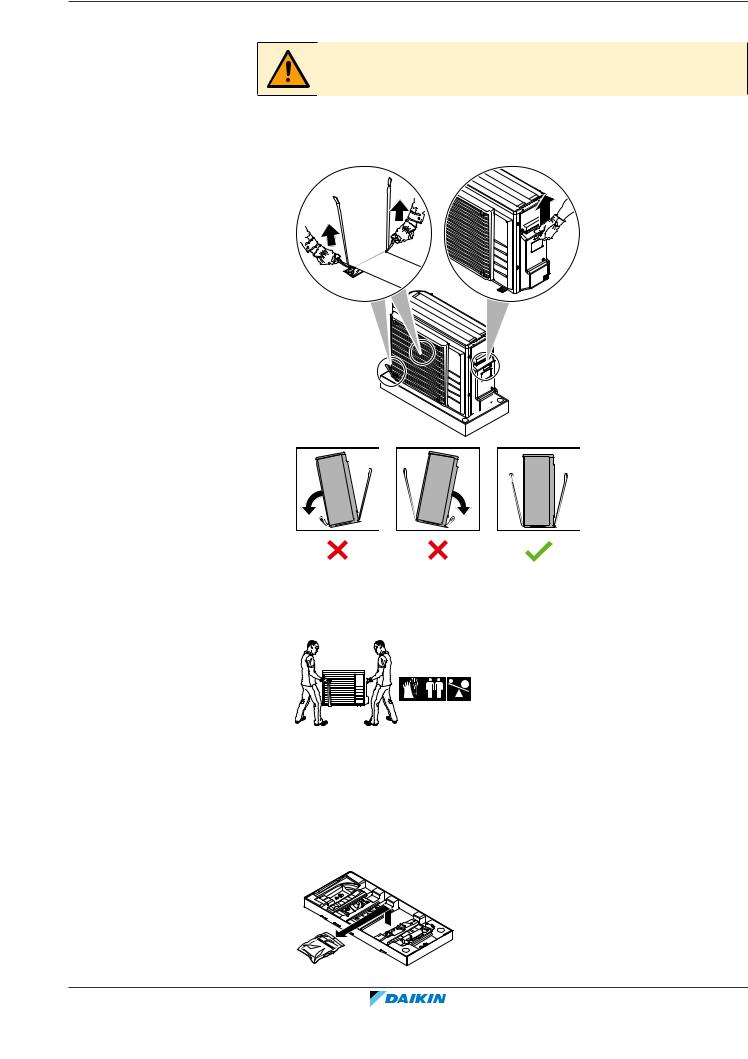
4 | About the box
4.2.2 To handle the outdoor unit
CAUTION
To avoid injury, do NOT touch the air inlet or aluminium fins of the unit.
1Handle the unit using the sling to the left and the handle to the right. Pull up both sides of the sling at the same time to prevent disconnection of the sling from the unit.
1 |
2 |
|
|
1 |
|
2While handling the unit:
▪Keep both sides of the sling level.
▪Keep your back straight.
3After mounting the unit, remove the sling from the unit by pulling 1 side of the sling.
4.2.3To remove the accessories from the outdoor unit
1Lift the outdoor unit. See "4.2.2 To handle the outdoor unit" [421].
2Remove the accessories at the bottom of the package.
ERGA04~08EAV3(A) + EHVH04+08SU18+23EA6V |
Installer reference guide |
Daikin Altherma 3 R F |
21 |
4P629090-1 – 2020.08 |
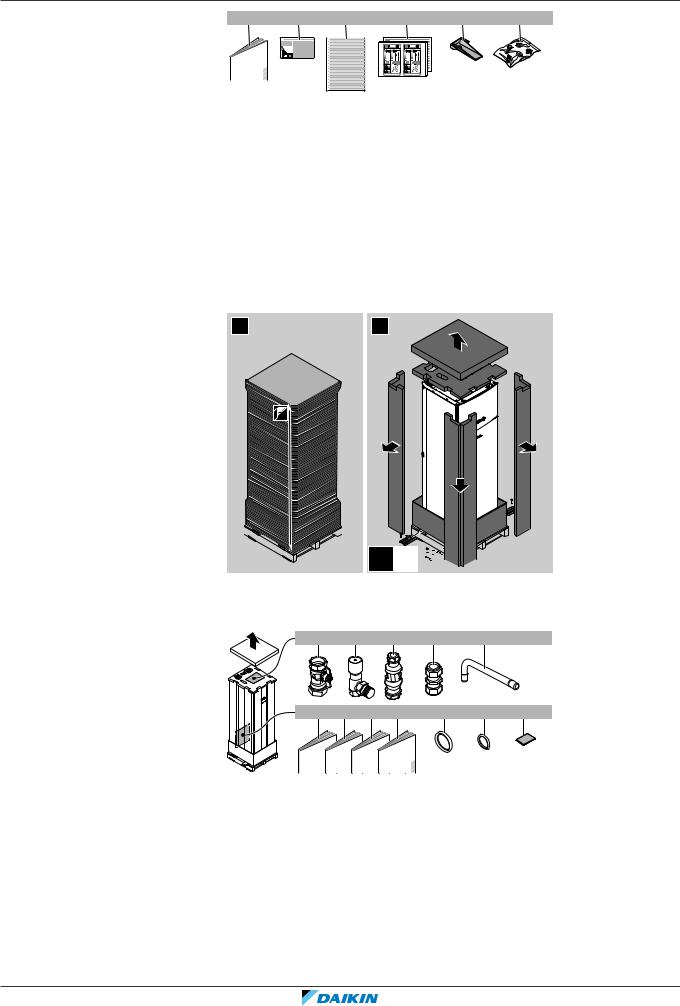
4 | About the box
a |
b |
c |
d |
e |
f |
1× |
1× |
1× |
1× |
2× |
1× |
|
|
ENERG |
ENERG |
|
|
aOutdoor unit installation manual
bFluorinated greenhouse gases label
cMultilingual fluorinated greenhouse gases label
dEnergy label
eUnit mounting plate
fBolts, nuts, washers, spring washers and wire clamp
4.3 Indoor unit
4.3.1 To unpack the indoor unit
1 |
|
|
|
2 |
|||||||
|
|
|
|
|
|
|
|
|
|
|
|
|
|
|
|
|
|
|
|
|
|
|
|
|
|
|
|
|
|
|
|
|
|
|
|
|
|
|
|
|
|
|
|
|
|
|
|
|
|
|
|
|
|
|
|
|
|
|
|
|
|
|
|
|
|
|
|
|
|
|
|
|
|
|
|
|
|
|
|
|
|
|
|
|
|
|
|
|
|
|
|
|
|
|
|
|
|
|
|
|
|
|
|
|
|
|
|
|
|
|
|
|
|
|
|
|
|
|
|
|
|
|
|
|
|
|
|
|
|
|
|
|
|
|
|
|
|
|
|
|
|
|
|
8× 



4.3.2 To remove the accessories from the indoor unit
a |
b |
|
c |
d |
e |
|
4× |
1× |
|
1× |
1× |
1× |
|
f |
g |
h |
i |
j |
k |
l |
1× |
1× |
1× |
1× |
8× |
4× |
1× |
aShut-off valves for water circuit
bOverpressure bypass valve
cTundish (to mount onto the pressure relief valve discharge pipe)
dBrass compression coupler
eDischarge pipe (for pressure relief valve)
fGeneral safety precautions
gAddendum book for optional equipment
hIndoor unit installation manual
iOperation manual
jSealing rings for shut-off valves (space heating water circuit)
kSealing rings for field-supplied shut-off valves (domestic hot water circuit)
lSealing tape for low voltage wiring intake
Installer reference guide |
ERGA04~08EAV3(A) + EHVH04+08SU18+23EA6V |
22 |
Daikin Altherma 3 R F |
4P629090-1 – 2020.08 |

4 | About the box
4.3.3 To handle the indoor unit
Use the handles at the back and at the bottom to carry the unit.
a |
a |
b |
b |
aHandles at the back of the unit
bHandles at the bottom of the unit. Carefully tilt the unit to the back so that the handles become visible.
4.4Domestic hot water tank kit
4.4.1 To remove the accessories from the domestic hot water tank kit
a b
c  d
d
e
f
g
aPressure reducing valve/pressure relief valve combination. Water inlet and water outlet 22 mm connection, discharge piping connection 15 mm
bAdaptor 22 mm×3/4" Female BSP
cT-piece 22 mm×22 mm×22 mm
dTundish 15 mm inlet, 22 mm outlet
eWall mounting set for expansion vessel
fInstruction sheet
gExpansion vessel of 18 l – 3/4" Male BSP
NOTICE
All piping MUST be installed according to section G3 of the Building Regulations.
4.5 Checklist for the required DHW accessories
For installation compliant with section G3 of the Building Regulations, you must
verify that the following accessories are present.
ERGA04~08EAV3(A) + EHVH04+08SU18+23EA6V |
Installer reference guide |
Daikin Altherma 3 R F |
23 |
4P629090-1 – 2020.08 |

4 | About the box
Delivered with indoor unit:
Tundish 15 mm inlet, 22 mm outlet
Delivered with domestic hot water tank kit:
Pressure reducing valve/pressure relief valve combination
Adaptor 22 mm×3/4" Female BSP
T-piece 22 mm×22 mm×22 mm
Tundish 15 mm inlet, 22 mm outlet
Wall mounting set for expansion vessel
Instruction sheet
Expansion vessel of 18 l – 3/4" Male BSP
Installer reference guide |
ERGA04~08EAV3(A) + EHVH04+08SU18+23EA6V |
24 |
Daikin Altherma 3 R F |
4P629090-1 – 2020.08 |

5 | About the units and options
5 About the units and options
In this chapter
5.1 |
Overview: About the units and options ................................................................................................................................. |
25 |
|
5.2 |
Identification........................................................................................................................................................................... |
25 |
|
|
5.2.1 |
Identification label: Outdoor unit .......................................................................................................................... |
25 |
|
5.2.2 |
Identification label: Indoor unit ............................................................................................................................. |
26 |
5.3 |
Combining units and options.................................................................................................................................................. |
26 |
|
|
5.3.1 |
Possible options for the outdoor unit.................................................................................................................... |
26 |
|
5.3.2 |
Possible options for the indoor unit ...................................................................................................................... |
27 |
5.1 Overview: About the units and options
This chapter contains information about:
▪Identifying the outdoor unit
▪Identifying the indoor unit
▪Combining the outdoor unit with options
▪Combining the indoor unit with options
5.2Identification
NOTICE
When installing or servicing several units at the same time, make sure NOT to switch
the service panels between different models.
5.2.1 Identification label: Outdoor unit
Location
Model identification
Example: ER G A 06 DA V3 A
|
Code |
Explanation |
|
ER |
European split outdoor pair heat pump |
|
|
|
|
G |
Medium water temperature – ambient zone: −10~−20°C |
|
|
|
|
A |
Refrigerant R32 |
|
|
|
|
06 |
Capacity class |
|
|
|
|
DA |
Model series |
|
|
|
|
V3 |
Power supply |
|
|
|
|
|
|
ERGA04~08EAV3(A) + EHVH04+08SU18+23EA6V |
Installer reference guide |
|
Daikin Altherma 3 R F |
25 |
|
4P629090-1 – 2020.08 |
||

5 | About the units and options
Code |
Explanation |
A |
A=Austrian model |
|
[—]=Non-Austrian model |
|
|
5.2.2 Identification label: Indoor unit
Location
Model identification
Example: E HV H 08 S U 23 EA 6V
Code |
Description |
E |
European model |
|
|
HV |
Floor-standing indoor unit with integrated tank |
|
|
H |
Heating only |
|
|
08 |
Capacity class |
|
|
S |
Integrated tank material: Stainless steel |
|
|
U |
UK model |
|
|
23 |
Integrated tank volume |
|
|
EA |
Model series |
|
|
6V |
Backup heater model |
|
|
5.3 Combining units and options
INFORMATION
Certain options might not be available in your country.
5.3.1 Possible options for the outdoor unit
Drain pan kit (EKDP008D)
The drain pan kit is required to gather the drain from the outdoor unit. The drain pan kit consists of:
▪ Drain pan
▪ Installation brackets
For installation instructions, see the installation manual of the drain pan.
|
Drain pan heater (EKDPH008CA) |
|
The drain pan heater is required to avoid freezing-up of the drain pan. |
|
It is recommended to install this option in colder regions with possible low ambient |
|
temperatures or heavy snowfall. |
|
For installation instructions, see the installation manual of the drain pan heater. |
|
|
Installer reference guide |
ERGA04~08EAV3(A) + EHVH04+08SU18+23EA6V |
26 |
Daikin Altherma 3 R F |
4P629090-1 – 2020.08 |

5 | About the units and options
U-beams (EKFT008D)
The U-beams are installation brackets on which the outdoor unit can be installed.
It is recommended to install this option in colder regions with possible low ambient temperatures or heavy snowfall.
For installation instructions, see the installation manual of the outdoor unit.
Low sound cover (EKLN08A1)
In sound sensitive areas (e.g. near a bedroom), you can install the low sound cover to decrease the operation noise of the outdoor unit.
You can install the low sound cover:
▪On mounting feet to the ground. This must withstand 200 kg.
▪On brackets to the wall. This must withstand 200 kg.
If you install the low sound cover, you also need to install one of the following options:
▪Recommended: Drain pan kit (with or without drain pan heater)
▪U-beams
For installation instructions, see the installation manual of the low sound cover.
5.3.2 Possible options for the indoor unit
User interface used as room thermostat (BRC1HHDA)
▪The user interface used as room thermostat can only be used in combination with the user interface connected to the indoor unit.
▪The user interface used as room thermostat needs to be installed in the room that you want to control.
For installation instructions, see the installation and operation manual of the user interface used as room thermostat.
Room thermostat (EKRTWA, EKRTR1)
You can connect an optional room thermostat to the indoor unit. This thermostat can either be wired (EKRTWA) or wireless (EKRTR1).
For installation instructions, see the installation manual of the room thermostat and addendum book for optional equipment.
Remote sensor for wireless thermostat (EKRTETS)
You can use the remote indoor temperature sensor (EKRTETS) only in combination with the wireless thermostat (EKRTR1).
For installation instructions, see the installation manual of the room thermostat and the addendum book for optional equipment.
Digital I/O PCB (EKRP1HBAA)
The digital I/O PCB is required to provide following signals:
▪Alarm output
▪Space heating/cooling On/OFF output
▪Changeover to external heat source
For installation instructions, see the installation manual of the digital I/O PCB and addendum book for optional equipment.
ERGA04~08EAV3(A) + EHVH04+08SU18+23EA6V |
Installer reference guide |
Daikin Altherma 3 R F |
27 |
4P629090-1 – 2020.08 |
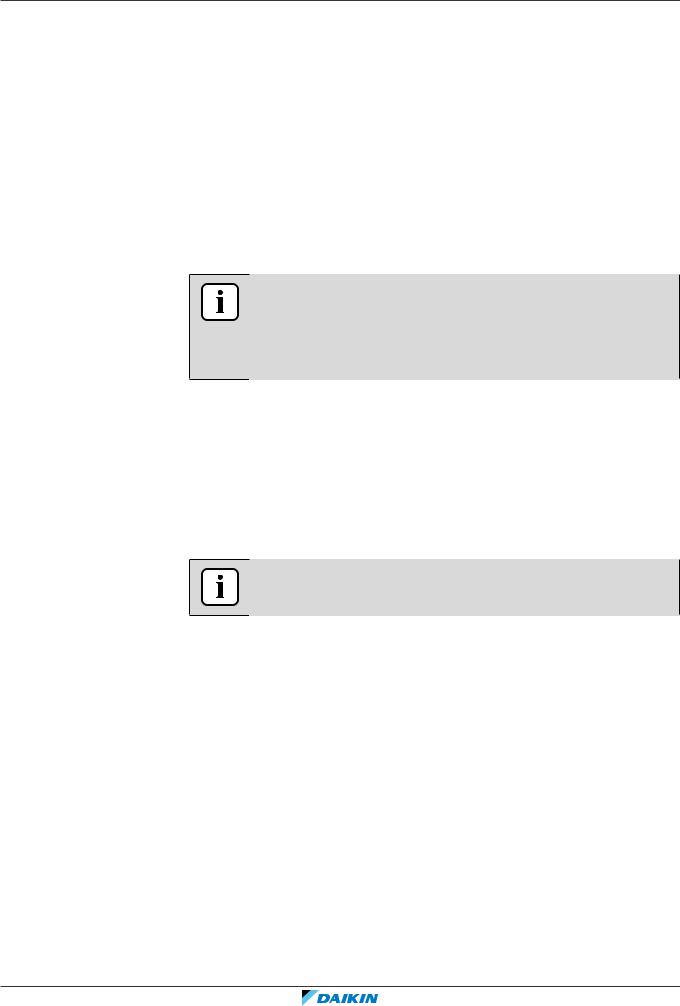
5 | About the units and options
Demand PCB (EKRP1AHTA)
To enable the power saving consumption control by digital inputs you must install the demand PCB.
For installation instructions, see the installation manual of the demand PCB and addendum book for optional equipment.
Remote indoor sensor (KRCS01-1)
By default the internal user interface sensor will be used as room temperature sensor.
As an option the remote indoor sensor can be installed to measure the room temperature on another location.
For installation instructions, see the installation manual of the remote indoor sensor and addendum book for optional equipment.
INFORMATION
▪ The remote indoor sensor can only be used in case the user interface is configured with room thermostat functionality.
▪You can only connect either the remote indoor sensor or the remote outdoor sensor.
Remote outdoor sensor (EKRSCA1)
By default the sensor inside the outdoor unit will be used to measure the outdoor temperature.
As an option the remote outdoor sensor can be installed to measure the outdoor temperature on another location (e.g. to avoid direct sunlight) to have an improved system behaviour.
For installation instructions, see the installation manual of the remote outdoor sensor and the addendum book for optional equipment.
INFORMATION
You can only connect either the remote indoor sensor or the remote outdoor sensor.
PC cable (EKPCCAB4)
The PC cable makes a connection between the switch box of the indoor unit and a
PC. It gives the possibility to update the software of the indoor unit.
For installation instructions, see the installation manual of the PC cable.
Pipe bend kit (EKHVTC)
When the indoor unit is installed in a place with limited space, a pipe bend kit can be installed to facilitate the connection to the refrigerant liquid and gas connections of the indoor unit.
For installation instructions, see the instruction sheet of the pipe bend kit.
Heat pump convector (FWXV)
For providing space heating/cooling, it is possible to use heat pump convectors (FWXV).
For installation instructions, see the installation manual of the heat pump convectors, and the addendum book for optional equipment.
Installer reference guide |
ERGA04~08EAV3(A) + EHVH04+08SU18+23EA6V |
28 |
Daikin Altherma 3 R F |
4P629090-1 – 2020.08 |

5 | About the units and options
LAN adapter for smartphone control + Smart Grid applications (BRP069A61)
You can install this LAN adapter to:
▪Control the system via a smartphone app.
▪Use the system in various Smart Grid applications.
For installation instructions, see the installation manual of the LAN adapter.
LAN adapter for smartphone control (BRP069A62)
You can install this LAN adapter to control the system via a smartphone app.
For installation instructions, see the installation manual of the LAN adapter.
Conversion kit (EKHVCONV4)
Use the connection kit to convert a heating only model to a reversible model.
For installation instructions, see the installation manual of the conversion kit.
WLAN adapter module (BRP069A71)
A WLAN cartridge (to be plugged into the MMI) is delivered as indoor unit accessory. Alternatively (e.g. in case of weak signal strength), you can install the optional wireless LAN adapter module BRP069A71.
For installation instructions, see the installation manual of the WLAN adapter module and the addendum book for optional equipment.
Smart grid relay kit (EKRELSG)
The installation of the optional Smart grid relay kit is required in case of high voltage Smart grid contacts (EKRELSG).
For installation instructions, see "9.3.11 To connect a Smart Grid" [4125].
ERGA04~08EAV3(A) + EHVH04+08SU18+23EA6V |
Installer reference guide |
Daikin Altherma 3 R F |
29 |
4P629090-1 – 2020.08 |
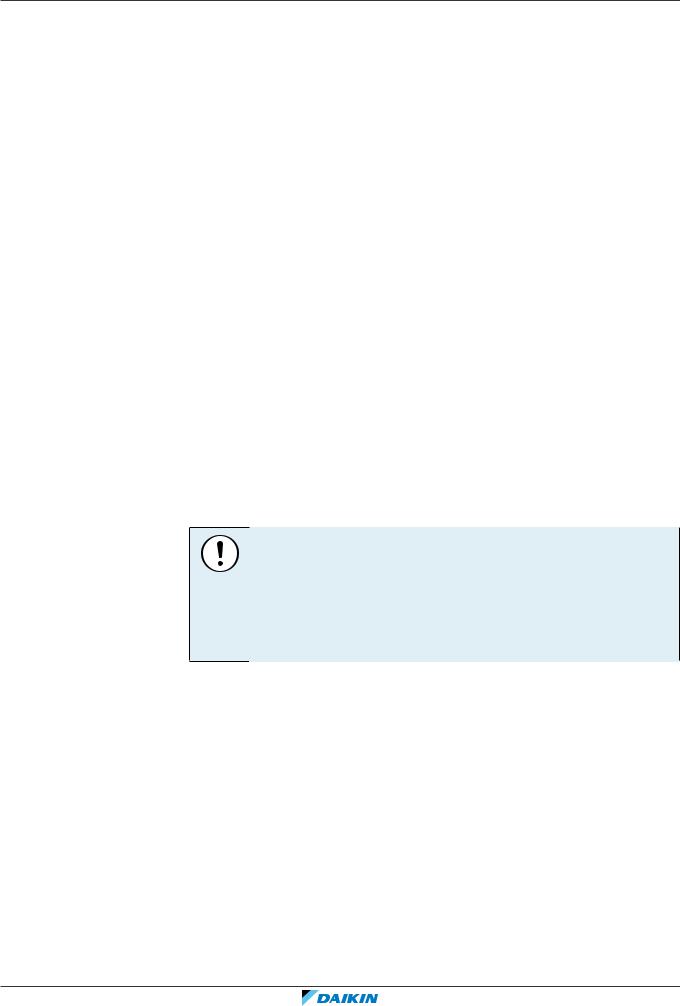
6 | Application guidelines
6 Application guidelines
In this chapter
6.1 |
Overview: Application guidelines ........................................................................................................................................... |
30 |
|
6.2 |
Setting up the space heating/cooling system ........................................................................................................................ |
30 |
|
|
6.2.1 |
Single room............................................................................................................................................................. |
31 |
|
6.2.2 |
Multiple rooms – One LWT zone ........................................................................................................................... |
35 |
|
6.2.3 |
Multiple rooms – Two LWT zones ......................................................................................................................... |
39 |
6.3 |
Setting up an auxiliary heat source for space heating........................................................................................................... |
41 |
|
6.4 |
Setting up the domestic hot water tank ................................................................................................................................ |
44 |
|
|
6.4.1 |
System layout – Integrated DHW tank .................................................................................................................. |
44 |
|
6.4.2 |
Selecting the volume and desired temperature for the DHW tank...................................................................... |
44 |
|
6.4.3 |
Setup and configuration – DHW tank .................................................................................................................... |
46 |
|
6.4.4 |
DHW pump for instant hot water .......................................................................................................................... |
46 |
|
6.4.5 |
DHW pump for disinfection ................................................................................................................................... |
47 |
6.5 |
Setting up the energy metering ............................................................................................................................................. |
47 |
|
|
6.5.1 |
Produced heat ........................................................................................................................................................ |
47 |
|
6.5.2 |
Consumed energy .................................................................................................................................................. |
48 |
|
6.5.3 |
Normal kWh rate power supply............................................................................................................................. |
48 |
|
6.5.4 |
Preferential kWh rate power supply...................................................................................................................... |
50 |
6.6 |
Setting up the power consumption control........................................................................................................................... |
51 |
|
|
6.6.1 |
Permanent power limitation.................................................................................................................................. |
51 |
|
6.6.2 |
Power limitation activated by digital inputs .......................................................................................................... |
51 |
|
6.6.3 |
Power limitation process ....................................................................................................................................... |
53 |
6.7 |
Setting up an external temperature sensor........................................................................................................................... |
53 |
|
6.1 Overview: Application guidelines
The purpose of the application guidelines is to give a glance of the possibilities of the heat pump system.
NOTICE
▪ The illustrations in the application guidelines are meant for reference only, and are NOT to be used as detailed hydraulic diagrams. The detailed hydraulic dimensioning and balancing are NOT shown, and are the responsibility of the installer.
▪For more information about the configuration settings to optimize heat pump operation, see "10 Configuration" 4[ 131].
This chapter contains application guidelines for:
▪Setting up the space heating/cooling system
▪Setting up an auxiliary heat source for space heating
▪Setting up the domestic hot water tank
▪Setting up the energy metering
▪Setting up the power consumption control
▪Setting up an external temperature sensor
6.2Setting up the space heating/cooling system
The heat pump system supplies leaving water to heat emitters in one or more
rooms.
Installer reference guide |
ERGA04~08EAV3(A) + EHVH04+08SU18+23EA6V |
30 |
Daikin Altherma 3 R F |
4P629090-1 – 2020.08 |
